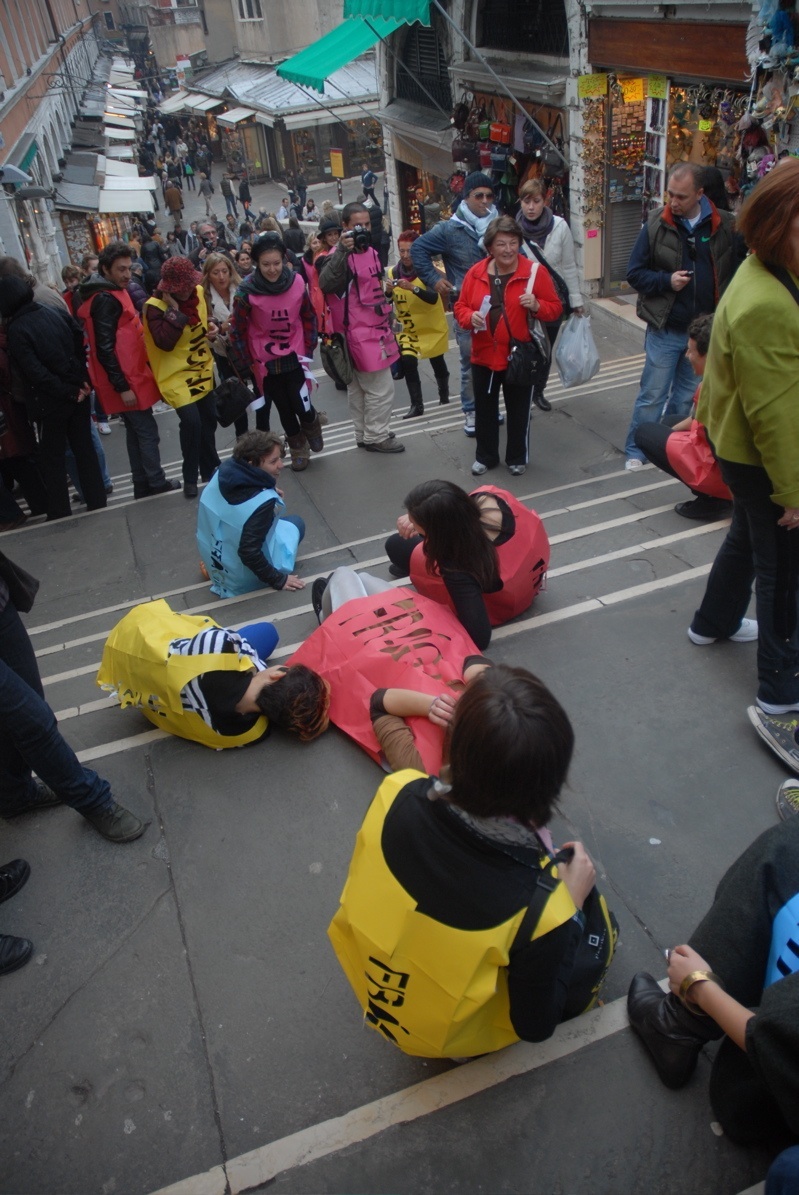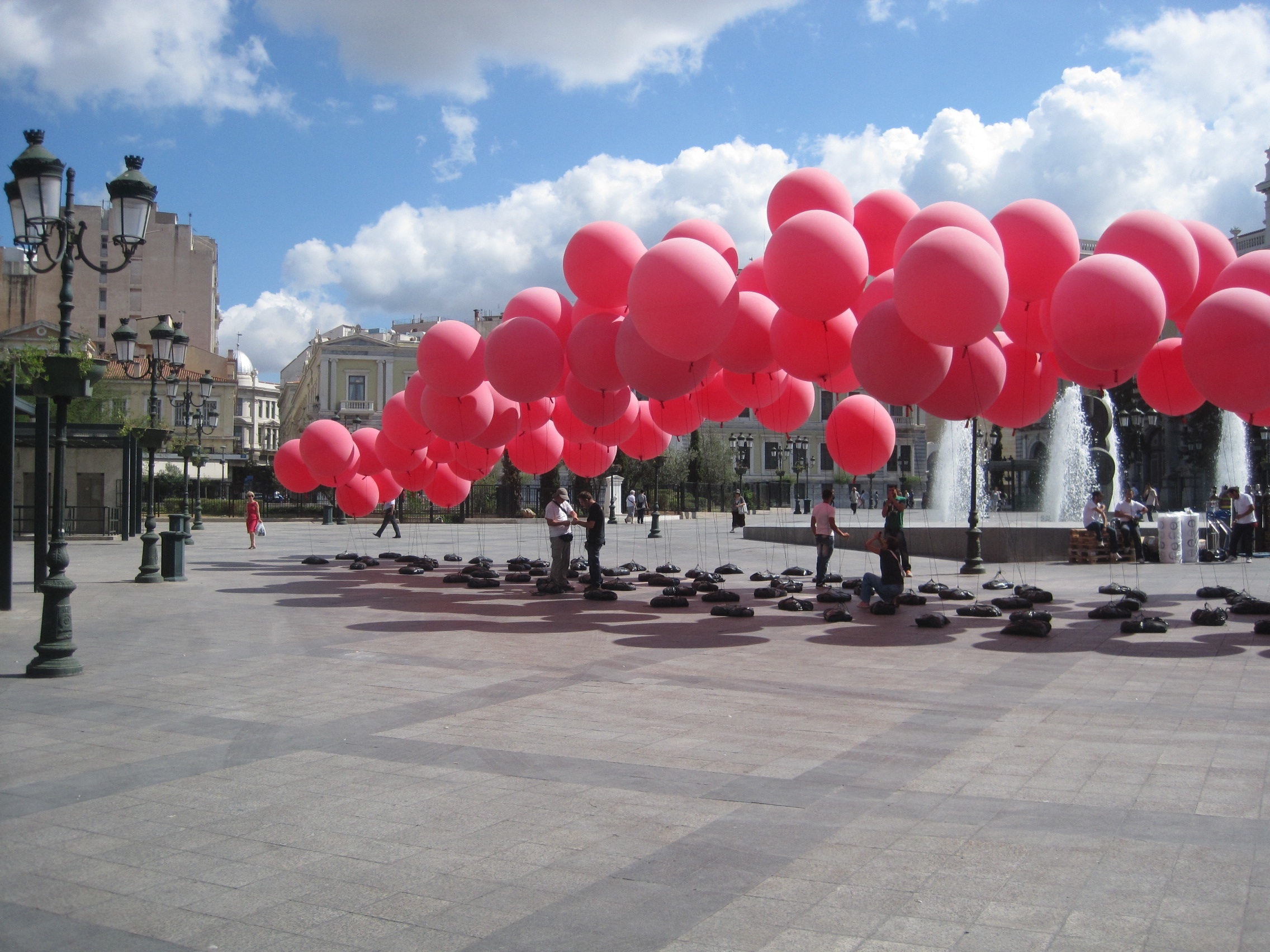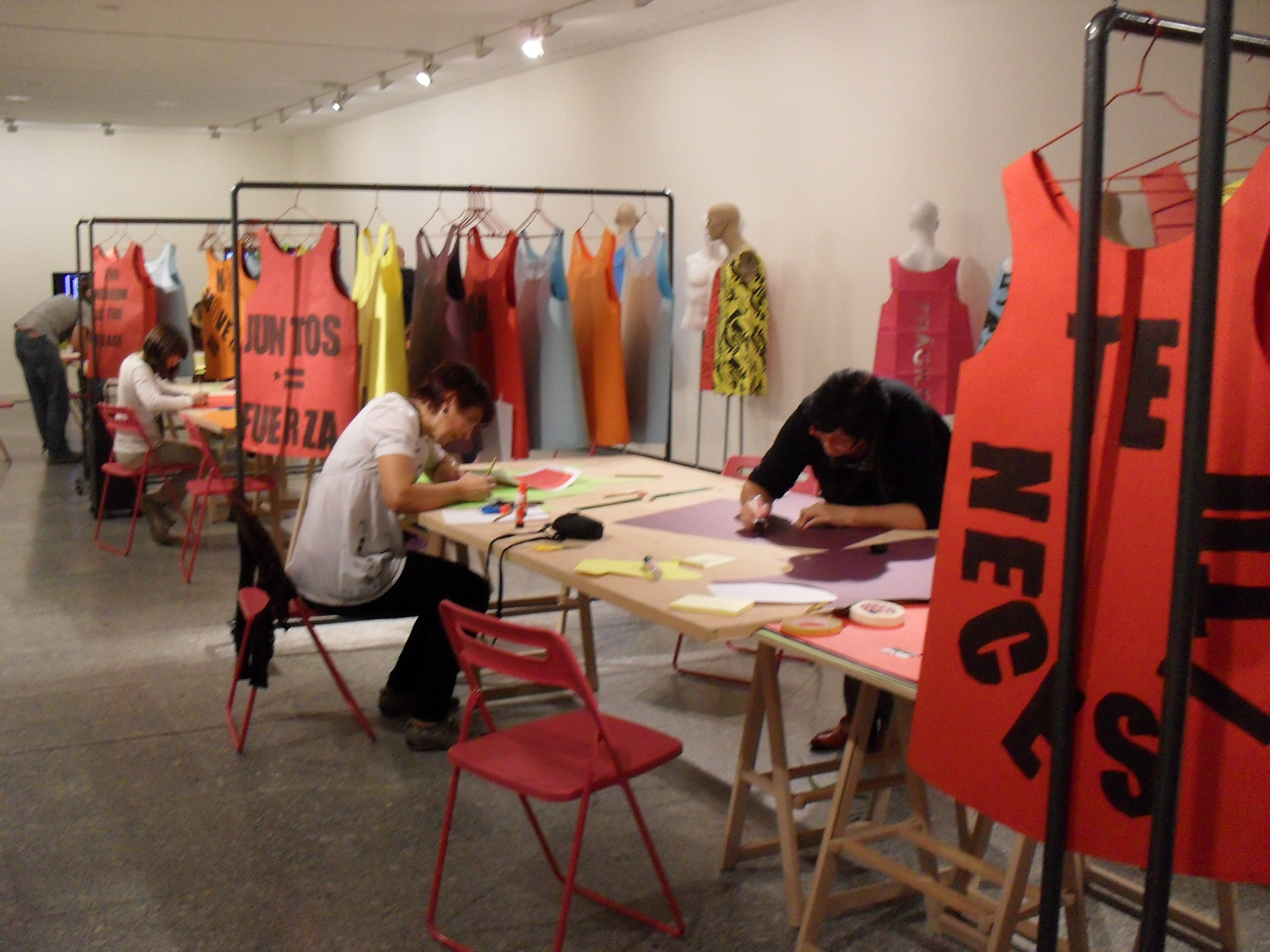Jenny Marketou was born and raised in Athens, Greece and educated in the United States. She lives and works in New York. Marketou earned a BFA from the Corcoran School of Art in Washington DC, and an MFA from Pratt Institute in Brooklyn, New York. She also studied photography with Duane Michaels at the International Center of Photography in New York and has participated in numerous workshops during the summer breaks as well as residency programs in the United States.
One of the most important residencies that gave a new direction to Marketou’s life and work was a three-month program at Banff, Canada in 1998. That experience fed her practice through continuous collaborations at Banff and with some of the residents through 2002. At Banff, she had the opportunity to meet and later collaborate with international artists as well as some of the hackers and anarchists who initiated the net art movement–Heath Bunting, Alex Shulgin, the Yes Men, Critical Art Assemble, Vuc Gosic, Natalie Bookchin, Fran Ilich and others under the mentorship of people like Sara Diamond, Sylvère Lotringer, Peter Weibel, Kathleen Hayles, Bruno Latour, Lev Manovich, and Tom Levine. The friendships that developed during that program have had an enormous influence on Marketou’s subsequent practice.
Earlier this month, Paperophanies was commissioned by the Praxis Project Gallery at Atrium Art Museum in Vitoria, in collaboration with local communities, artists, universities, and foundations as well as the Guggenheim in Bilbao. The project was inaugurated in the Basque Country in Spain and was curated by Blanca de la Torre. According to the exhibition description, Paperophanies “offers new kinds of mechanisms to explore collaboration, social relations, identity, fashion, action and the commons. Marketou has transformed the PRAXIS gallery into a fashion atelier where workshops take place daily, which after two months culminates into a public event in the form of a public protest ending in the Plaza de la Virgen Blanca.”
Marketou taught for many years at The Cooper Union School of Art in New York City and has lectured world-wide as a visiting artist at colleges and universities such as Parsons/the New School in New York City; Rutgers, NJ; Harvard, Cambridge; Montclair University; University of South Florida, Tampa, FL, among others. Her work can be found in public and private collections from the National Museum of Contemporary Art in Athens, Greece to Museo Reina Sophia, Madrid, Spain, and has been featured in numerous publications including Flash Art, Art Forum and Spiegel.
She is the epitome of a “busy-bee,” with the energy and critical insight that today’s art world requires. Marketou’s studio is located in DUMBO, Brooklyn, by the East River between Manhattan and Brooklyn Bridge. I have followed her work since 2005, yet I rarely have the opportunity to indulge in a good art conversation with her due to the ocean that separates us. When we do talk, Marketou makes every word and every minute count. I’ve made a job out of hunting down good art conversations, and it’s not often that I come across an artist who can play art ping-pong with words, without necessarily referring to their work or mine. I am a devoted fan of artists who can think and speak about issues taking place outside of the limits of their studio walls. Marketou is certainly one of them.
That said, the focus of our discussion does concern Marketou’s own studio practice; I highly encourage you to meet her in person and pay her a proper studio visit yourself.
I am very pleased to present artist Jenny Marketou.
Georgia Kotrtetsos: I remember us planning this interview around the projects you would be exhibiting this fall. One of them is the Red Eyed Sky Walkers (RESW) piece – which unfortunately is no longer with us. I’m referring to the large-scale outdoor installation at Kotzia Square in Athens, Greece. The project was organized by the National Museum of Contemporary Art (EMST) and curated by its director, Anna Kafetsi, who has been a supporter of your work for several years. What do you think led to the vandalism and stealing of this work? [Ed. note: a few hours after it was unveiled, the installation was dismantled by vandals, who removed the balloons, leaving only the bags of cement used as anchors behind]. The Minister of Culture, Pavlos Geroulanos, published a statement which seemed to suggest the act was somehow excusable. What was your experience of this incident?
Jenny Marketou: I feel somewhat more detached from the situation now and see things in a more pragmatic and clear way. I must say that the theft of my work, along with the vandalism of other public artworks in Athens, is the tip of the iceberg. First, because of the types of pragmatics that have emerged in Greek society and culture, which has undergone such dramatic political, economic and social changes over the last decade. And second, the fact that public art in Greece has always been a target, because the general public is totally disengaged with this kind of artistic output, even on the level of simple debate.
In reference to the statement made by Pavlos Geroulanos, I would like to quote Alexander Kluge: “In danger and emergency, to choose the middle leads to a certain death.” So in my opinion, instead of referring to the theft of my work as another case of vandalism by villains and outcasts, he should allow that incident to become the focus of a more engaged and nuanced dialogue about a range of cultural practices and their relevance in times of urgency. This is also the job of cultural practitioners, cultural and art institutions, and artists, myself included. Perhaps we should have a dialogue about what kinds of art production in the 21st century can address multiple audiences and invent new production structures. And we should question whether it is possible for art to cross the borders of the protected space of the museum or the gallery and to establish new values, real values, the values of the precarious-–which is uncertainty, instability and self-authorization.
Going back to Red Eyed Sky Walkers, the work belongs to the permanent collection of EMST, so I was not involved in the practical preparations of the installation at Plateia Kotzia. However, I was very excited by the idea that the work would move out of the safe, stable, and secure place of the museum in order to be shown in a more precarious space. And since I was aware of the uncertainty and instability and dangers of that square in Athens, and secondly knowing that I was not going to be present to attend to the work, I had been reassured that measures were being taken to protect the work from all those public risks. But apparently this was not the case.
But what counts is that we all made the attempt to show the work to the public. I had an experience which was cruel and discouraging but also magnificent. The experience of Red Eyed Sky Walkers makes sense to me, after all I am an artist with the ambition of involving a “non-exclusive” public in my work, a public to which we all belong.

Jenny Marketou. "Silver," 2011. Installation consisting of 99 mylar balloons, 9 video cameras, tethers, weight, batteries,9-channel video live broadcast through the Internet featuring Youtube data with aerial data from cameras attached to the weather balloons, video cameras, tethers, weight, batteries, projector. KUMU Art Museum, Tallin, Estonia (Cultural Capital of Europe).
GK: But let’s talk about Red Eyed Skywalkers as a work of art itself. It’s ethereal, inviting, playful, informative, and engaging. The work has evolved over the years and you have shown different versions of it depending on the needs of the project and the venue. How far back into your practice does the earliest version of the piece take us, and what has changed since then, conceptually as well as aesthetically?
JM: I love to set up projects or turn ideas into projects, so that after the original production and display they can continue to have a life of their own. RESW is one of those projects. Since October 24, 2007, when for the first time the work was launched in the Theater Platz among the public works of Serra and Paul Klee between the Theater and the Kunsthalle and simultaneously remotely through video streaming with the Dreispitzhalle, Basel (commissioned by Plug IN Gallery and the Shift International festival), it has been presented as a series of outdoor and indoor networked installations in the Historic Playhouse Square Center and simultaneously on the public screens in the city of Cleveland. Soon after it was reincarnated in a version made for the departure and arrival terminals at San Pablo airport for the 3rd edition of the Biennial in Seville (October 2008); after that, for the outdoor courtyard and the project Room at EMST in Athens (2010), and most recently for the courtyard of Kuku Art Museum in Tallinn, Estonia(2011).
The main components of the installation are always included in each presentation of the work–the fluid and shifting, ephemeral ecology of the 99 large red latex weather balloons, which are attached to the ground by several tethers and networked with nine video cameras, each attached underneath a balloon. With the help of a computer, they broadcast real-time streaming video displayed as nine single-channel video projections.
What has changed are the spatial and visual arrangements of the balloons, which each time are reconfigured in response to the architecture as well as to the current weather conditions. But what has really evolved through the series is the reverse practice of observation of the viewers. At first it was conceived as a network of all the cameras which, through the Internet, were remotely broadcasting all the aerial activity between visitors and the environment. And thus visitors were engaged in a game of performance and surveillance.
In the series at EMST and Kumu Art Museum, and most recently at Plateia Kotzia, rather than triggering the participation of the audience, I wanted to implicate them. In the spirit of transparency on the one hand, I wanted to examine how the display video broadcast from the cameras can create a zone around which the reality and fiction of images meet and function as a middle point between the audience and adequately represent events which are not local. To achieve this, I designed software that used the internet and allowed real-time streaming video from the balloon cameras to be simultaneously reassembled and displayed. My motive is to challenge the viewers so they become involved, and they also have to provide their own interpretations.
In his book You Are Not A Gadget, Jaron Lanier calls for a more humanist approach to the way we participate in network culture. Red Eyed Sky Walkers hopefully speaks to this desire, and reveals the human within the networked interface.
GK: Having addressed the fragility of an artwork, let’s take a minute to address the fragile state of the art participant or audience member. The Fragile project consists of handcrafted wearables that audience members voluntary sport at crowded art events and other locations. What I enjoy about the work is the commitment each participant makes in visually communicating their participation in the project by wearing the garment. What constitutes the fragile state of an audience member, who is also a participant in the art world?

Jenny Marketou. "Fragile." Performance/Intervention for 100 participants dressed in specially-designed paper garments with cut-outs spelling the word “FRAGILE." Rialto Bridge, Venice, 2010.
JM: Artworks that bring together objects, presence and performance have always interested me – since they are a part of a rich tradition of live art works from artists such as Andy Warhol, Joseph Beuys, Lygia Clark, Alastair MacLennan, Anne Bean, Stuart Sherman, and Rebecca Horn, for whom an installation using space, found or sculptural objects is seen as inseparable from a performed act.
Your question sounds rather ambivalent and I will answer it with a philosophical answer. In Fragile I wanted first to situate the role of the audience away from that of passive consumer of the art world, into that of the producer and the performer of the work. Participants in Fragile are dressed in the artwork, which materializes itself as a series of bodily reenactments of non-scripted, precarious situations–almost like the psychogeographic detournements of the Situationists. On one hand, the “fragile” state of the audience in the living form of becoming and acting induces freedom, visibility and a field of autonomous space. On the other hand, to give form to the precarious is to accept an awareness of “the fragility of life,” which compels the audience to be awake, present, open, and active. In Precarious Life, Judith Butler’s short essay on Emmanuel Levinas, she writes that “In some way we come to exist in the moment of being addressed and something about our existence proves precarious when the address fails.”
GK: In your video project We Love Candy But Out Passion is Collecting Art, a 16 year old collector named Ben Slome tells us that “Art collecting has become more of a sport and competition between the various high-society wealthy people.” Can Ben be right? What is your take on the collecting aspect of the art world; the art fairs; the role of the private museum; and the mechanisms that bring private collections into the foreground of the art world and on the covers of art magazines world wide?
[youtube:https://www.youtube.com/watch?v=8XMGu3ZD-Uk]
JM: I agree with Ben. The art of collecting has always been the privilege of a certain affluent group of people, but it used to convey some kind of personal or even spiritual integrity apart from its market value. But I would agree with Ben that collecting has become an “excessive sport for the rich and famous” through the hype of the market-driven art world and the continuously-growing number of art fairs, galleries, and biennials. Collecting art is like buying real estate or couture fashion, and art collectors have become as powerful as big real estate tycoons. Most of the commercial art galleries, museums and biennials show artists and art which has became hegemonic, boring, and meaningless. They showcase and overproduce work by the same artists whose work is owned by the same private collections, and they cater to the “taste” and investments of those collectors. Art museums and art institutions, curators and even artist residency programs follow because their livelihood depends on private support. By the way, the role of the art collector recently has crossed over into curating museum shows and international biennials. So the audience member is part of this system yet not always aware of the distortions of the global hegemonic and market-oriented art world, which is totally uninterested in any alternative positions.
As a professional artist it is hard to bite the hand that feeds you, and I collaborate with art institutions, museums and galleries and show my work in art biennials. But I refuse to be depressed about what happens in the art market, and I am always willing to act, to take risks against the status quo, and to create the kind of work that I want to do. This gives me hope and makes me happy.
GK: Is it at your studio at Dumbo where the creative magic happens or do things develop on the road – one thing leads you to the next?
JM: I love my studio and when I am in New York every day I spend my entire day at my studio. My studio is the place where I experience those valuable moments of slowness and silence. Sometimes just reflecting, sometimes writing but mainly researching and working with my assistant on prototyping and developing already-born ideas. But I am a nomadic artist and in fact my work is nomadic and socially engaged in the sense of the variety of mediums, themes, public pedagogy and modes of production that I am always interested in working with. I would say that the actual ideas are born mainly on the road, stored in my mind and on my laptop, and are usually materialized in situ. I am always interested in the energy which is created through the actual work, and not the material or the medium used. In most of the cases I try to be present through the production of the work, which allows me a certain kind of bonding with my audience and my peers.
GK: Talk to us about Paperophanies shown at the Praxis room at Artium Museum in Vitoria, Basque country, Spain, and the Spanish art audience, since you’re returning for the 10th time or so to present a project–and in this case a solo project. What draws you back to that part of the art world?
JM: I guess you are right. I hadn’t really thought of this but the Spanish art world in general has always been supportive of my work. I have had the opportunity to work with many interesting curators and important art museums in different regions of Spain such as Reina Sofia in Madrid, Laboral in Cijon, the Biennial of Seville and now at Artium Museum in the Basque Country. At first sight the art world seems very conservative and small, but what makes Spain so attractive to me is that although it appears like one country it is really a country of many countries, where every region has its own cultural traditions, landscape, food and language. So this diversity in the country’s texture reflects also the many opportunities that are presented in the art world for international artists like myself. I also believe that what subconsciously pulls me back there is the fact that I have made many friendships. Spain feels like my home away from home.
And, that’s a wrap!









Pingback: Image Slider « Summer Gidget
Pingback: TB Studio Instead of Going to Lecture Assignment | kkarlmcf